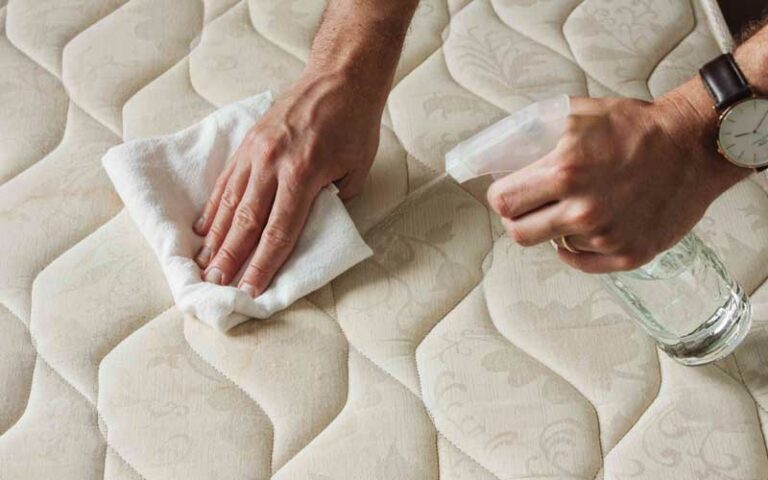When purchasing a bed for your home, it’s essential to consider the accompanying items, such as a bed frame, bedding products, and, most importantly, a comfortable and supportive mattress. Your mattress choice significantly impacts your sleep quality, making it a crucial investment. However, some people make the mistake of thinking that once they buy a new mattress, they no longer need to take care of it and keep it clean.
In this guide, we’ll provide detailed instructions on how to clean a mattress and offer helpful tips and advice to ensure your mattress remains fresh and hygienic. Whether you need to remove stubborn stains or want to know how to maintain your mattress’s cleanliness, we’ve got you covered. Keep reading to learn how to achieve a clean and comfortable sleep environment.
Why should you clean your mattress?
here are several reasons why it’s important to clean your mattress regularly:
- Hygiene: Mattresses can harbour various bacteria, allergens, and dust mites that can cause allergies, asthma, and other health problems. Regular cleaning can help remove these contaminants and create a healthier sleeping environment.
- Odour control: Over time, mattresses can develop unpleasant odours from sweat, body oils, and other sources. Cleaning your mattress can help remove these odours and create a more pleasant sleeping environment.
- Prolonged lifespan: Regular cleaning and maintenance can help extend the lifespan of your mattress by preventing wear and tear and maintaining its support and comfort.
- Better sleep: A clean mattress can help you sleep better by providing a more comfortable and hygienic sleeping environment, improving overall health and well-being.
Overall, cleaning your mattress is an important part of maintaining a healthy and comfortable sleeping environment. It can help prevent health problems, prolong the lifespan of your mattress, and promote better sleep.
How to properly clean your mattress?
We spend a third of our life sleeping, so you must ensure you have a good night’s sleep every night. A considerable part of the quality of your sleep will be your bed hygiene and how well you take care of your bed.
If you regularly clean your mattress, that will help with the reduction of allergens in your bedroom and prolong the bed’s life. Next, we’ll show you how to clean a mattress in eight easy steps with basic cleaning tools and ingredients. They are the following:
1. Strip the bed and wash bed linen
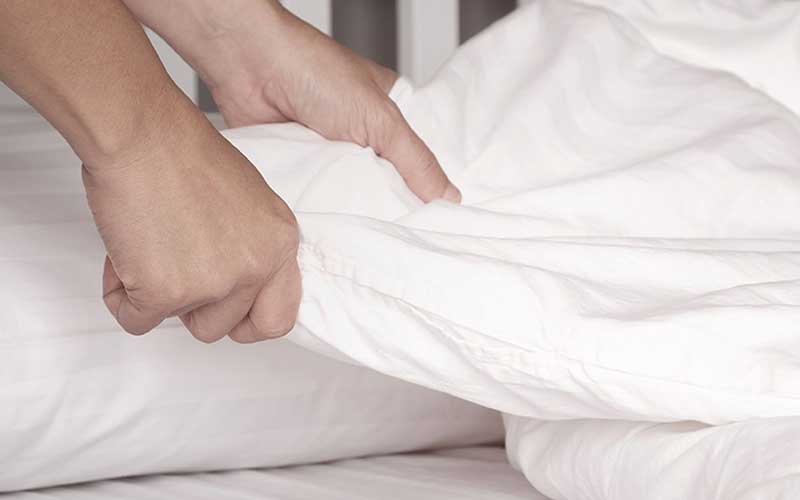
Before cleaning your mattress, remove everything covering it and put it in the washing machine (if possible). You can begin by stripping all the bedding and throwing them in the laundry basket to wash your sheets later. The items that aren’t washed, such as blankets and pillows, can be aired out and put away in a different part of the room so they aren’t in your way.
When you separate your bedding items, the one in the laundry basket can go into the washer to be cleaned, and you can start the cleaning process.
2. Vacuum your mattress
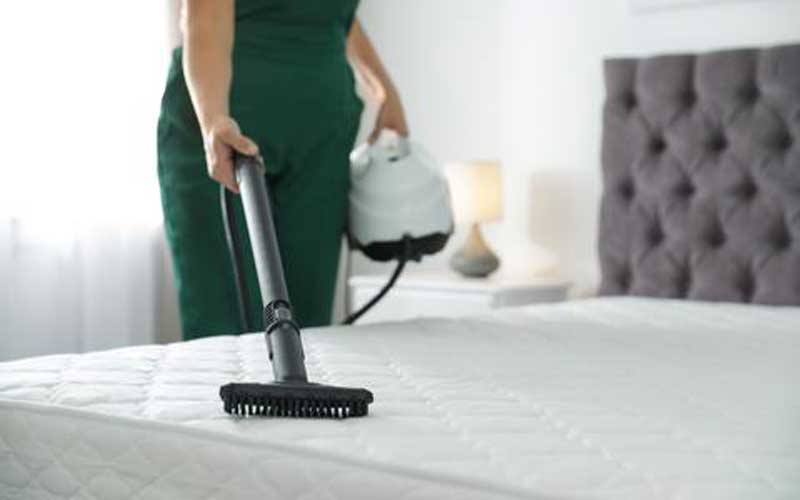
The first step of cleaning your mattress comes after you’ve stripped the bed. You must vacuum it to remove mites, dust, dead skin, hair, and other debris. We recommend using an attachment with a wide brush for the top and a lengthy upholstery nozzle for cracks, edges, sides and piping. Don’t forget to check if the attachments you’re using are clean before you turn the vacuum on.
3. Spot clean stains
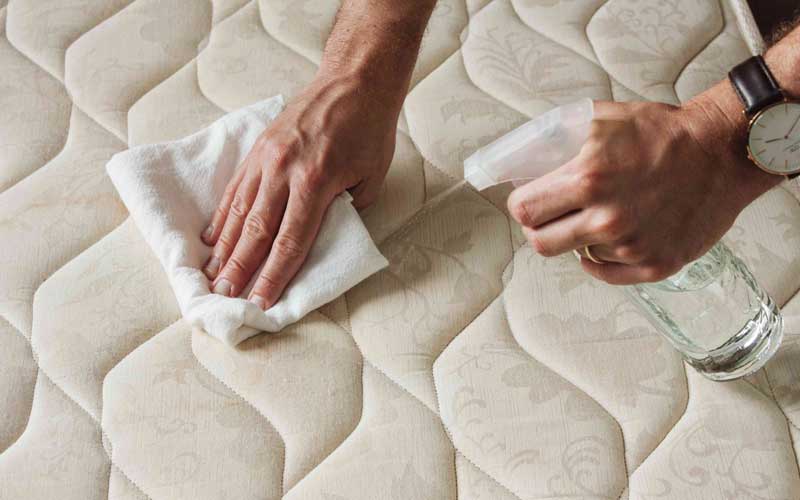
We want to start this part by saying that if any recent spills are still wet, you should clean them immediately. You can do so by blotting a clean cloth that is damp with cold water. Don’t scrub or rub it since it may push the stain farther into the mattress.
To clean an older stain, you must concoct two tablespoons (30 ml) of hydrogen peroxide with one tablespoon (15 ml) of liquid dish soap in a container. After you’ve made your mixture, it’s time to dip an old toothbrush into the suds and gently scrub until you receive the wanted effect.
Usually, this is an effective solution for treating stains from dirt, food, and drinks, but remember that if you have a memory foam mattress, you should be careful with the cleaner since it’s a material that shouldn’t get wet.
4. Use enzyme cleaner for biological stains

As we mentioned, the mixture above works only for specific stains, and if you need to clean biological ones, we have another solution. Start by sparing some enzyme cleaner onto a clean cloth and blotting the area to remove the stain. After you’ve done so, we highly recommend blotting it again with a clean cloth, damp with cold water.
Enzyme cleaners can break down many stains, such as blood, urine, sweat, vomit, oil, grease, etc. Plus, it’s helpful with odours, but don’t spray the liquid directly on the mattress because some materials, like memory foam, can get damaged.
5. Deodorise the mattress with baking soda
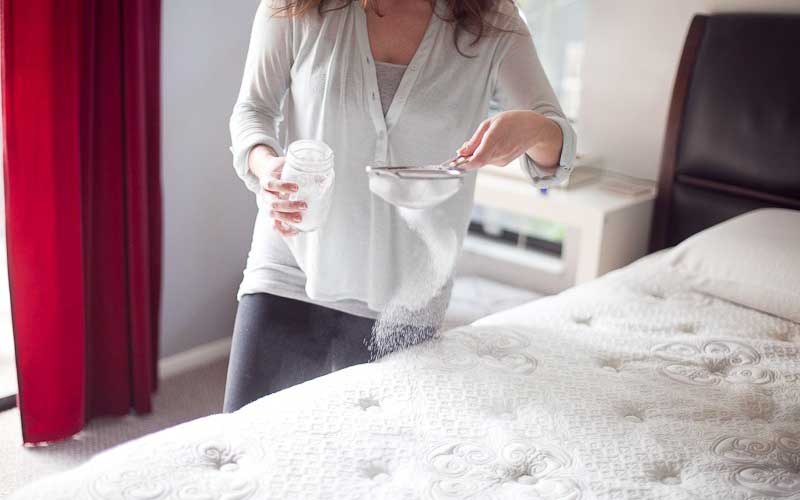
After you’ve dealt with the stains, it’s time to deodorise the whole mattress. How can you do that? Easy, sprinkle a generous amount of baking soda over the entire surface. And if you want your bed to smell extra nice, stir a few drops of your favourite essential oils into the baking soda. If you want the soda to be distributed evenly, pour it into a sifter and use it over your bed.
6. Let it sit and absorb
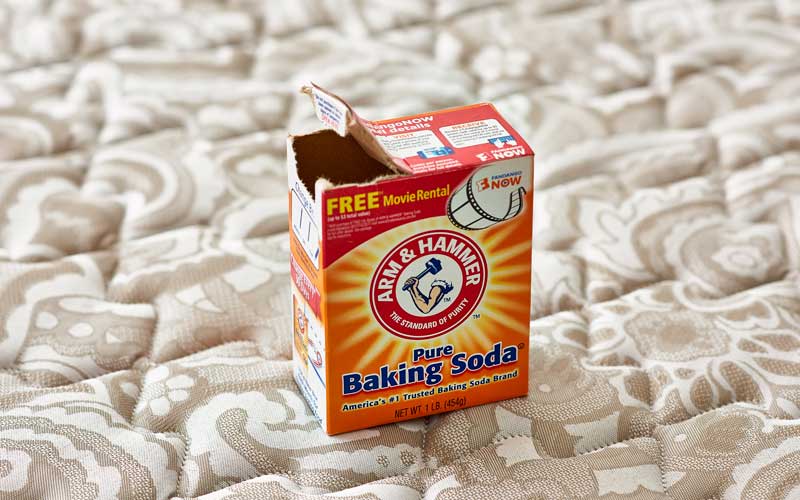
You must let the baking soda sit for at least 30 minutes to give it enough time to break down acids, absorb smells, and absorb any liquid leftover from your spot cleaning. But if you have the time, you can leave the baking soda on for a couple of hours. The longer you let it sit on the mattress, the better it will absorb and clean.
7. Another round of vacuuming
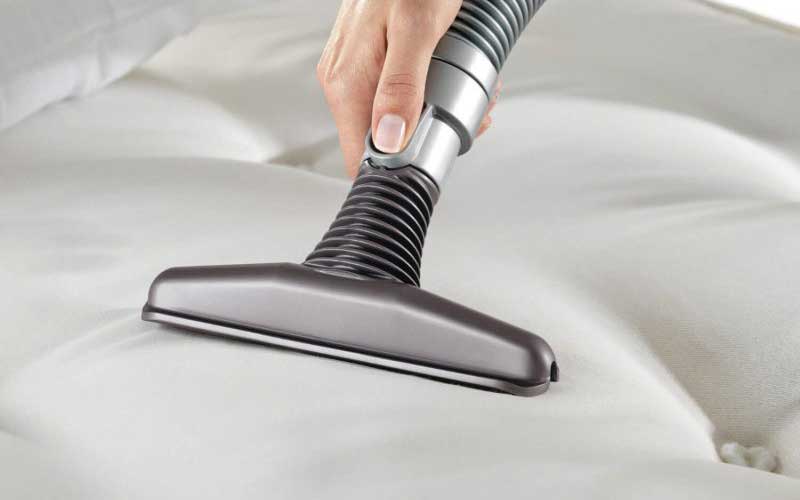
If you’ve given the baking soda enough time to sit, your next step will be to vacuum your mattress again to remove it. Doing so will take acids, odours, and liquids that the baking soda has absorbed. This time we recommend you use a brush to cover the top and a long nozzle to get into corners, cracks, seams, and piping.
8. Let the mattress air out

Finally, now that your mattress is clean, it will be best to let it air out for some time so that the left liquids can dry out (if there are any). This way, you’ll avoid the moisture that can get trapped inside and lead to mould, which is incredibly difficult to remove.
When the weather outside is warm, you can leave your bedroom window open during the day to let in the fresh air. Another way to keep bacteria and mould away is by keeping the curtains open since the UV rays in the sun will help kill them.
Why should you clean your mattress?
Cleaning your mattress regularly is important for maintaining good hygiene and prolonging its lifespan. Here are some reasons why you should clean your mattress often:
- Remove dust and allergens: Over time, your mattress can accumulate dust, dirt, dust mites and pet dander. Regular cleaning can help remove these particles and prevent them from causing allergies or respiratory problems.
- Prevent stains and odours: Stains and odours can build up on your mattress over time, especially if you eat or drink in bed. Regular cleaning can help prevent these issues and keep your mattress smelling fresh.
- Prolonged mattress lifespan: Regular cleaning can help remove dirt and debris that can damage the fibres of your mattress over time. This can help prolong its lifespan and prevent the need for premature replacement.
- Improve sleep quality: A clean and hygienic environment can help you sleep better and wake up refreshed. Removing allergens and odours can also help prevent sleep disruptions and improve sleep quality.
- Maintain warranty: Some mattress warranties require regular cleaning to remain valid. By cleaning your mattress often, you can ensure you meet the warranty requirements and protect your investment.
Cleaning your mattress regularly can improve your sleep quality, maintain good hygiene, and prolong its lifespan. You should clean your mattress at least twice yearly to keep it in good condition.
How often should you clean your mattress?

It’s recommended to clean your mattress at least every six months to keep it fresh and hygienic. However, the frequency of cleaning your mattress may depend on factors such as allergies, pets, or if you frequently sweat during sleep.
If you or someone in your household suffers from allergies or asthma, it’s recommended to clean your mattress more frequently, such as once every three months. Similarly, if you have pets that sleep on the bed with you or if you frequently sweat during sleep, it’s recommended to clean your mattress more frequently to prevent odors and bacteria buildup.
Regular cleaning and maintenance of your mattress can also help extend its lifespan and maintain its comfort and support. It’s important to follow the manufacturer’s recommendations for cleaning and care to avoid damaging the mattress.
How to maintain a clean mattress?
Now that we’ve discussed how often and how you can clean your mattress, it is time to talk about keeping it fresh and clean for as long as possible. Here are some tips to get that fresh feeling in-between mattress cleaning. The recommendations are the following:
- Air out your bed whenever you get a chance
- Throwback your sheets every morning for half an hour
- Keep your windows open during the day (if the weather allows it)
- Change your bedding regularly (wash and dry what you can)
- Spot-clean any stains you make while they are still fresh and wet
- Get yourself a mattress protector
- Be careful with food and drinks in bed (avoid them if possible)
How can you protect your mattress?
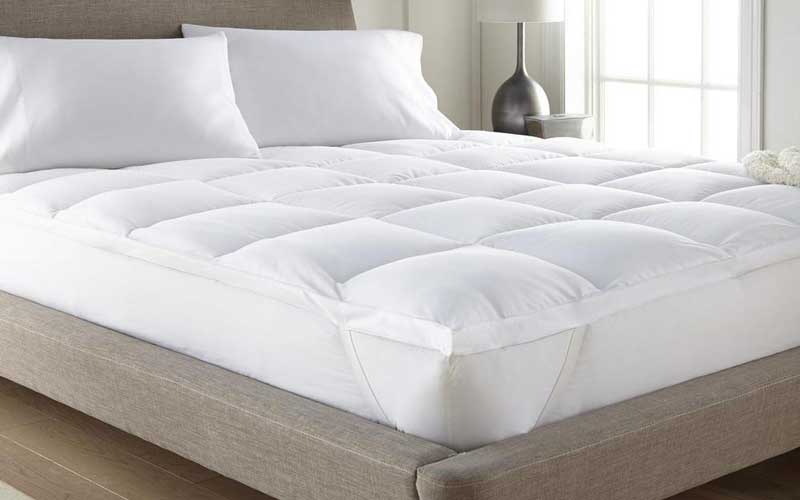
Let’s be honest. It’s better not to have coffee stains in the first place than to clean them, so you should find a way to protect your mattress from spills, stains and odours. We advise you to get a mattress protector since it’s a cost-effective way to keep your bed clean.
Overall, mattress protectors will protect your bed against spills and accidents, but what makes them even better is that they are also perfect for those who suffer from allergies. Most of them can be machine washed and tumble-dried to stay fresh and clean at all times. But if you aren’t sure if you can wash yours, you can also read the product’s instructions.
How often should you replace your mattress?
Let’s start by saying that if you’re already asking yourself this question, it’s probably time to change it. There might not be a set rule when you need to make a change, but if any of the following are true, that’s a good enough sign. Here are a few things you can do to maximise the lifespan of your mattress:
- Squeaking springs – if your springs are becoming nosier, that’s a good sign that your coils are no longer providing the support you need since they’ve been worn out.
- Signs of wear & tear may include lumps, sagging and even coils tearing through the fabric.
- Muscle stiffness – when your body feels sore and stiff, your mattress is no longer comfortable or supports your body and its needs.
- Allergies have worsened – with the years, mattresses collect most of the dust mites and allergens in your home, which is why they can hurt allergies and asthma.
- Gaining weight – sometimes, adding extra kilos can affect an older mattress and change your sleep quality.
- Partner’s movement – if the mattress needs replacement, it would have lost its ability to reduce motion transfer, thus why you can feel more action from your partner.
To learn more about this subject, look at our guide: How often should you change your mattress?
How to clean urine stains from a mattress?
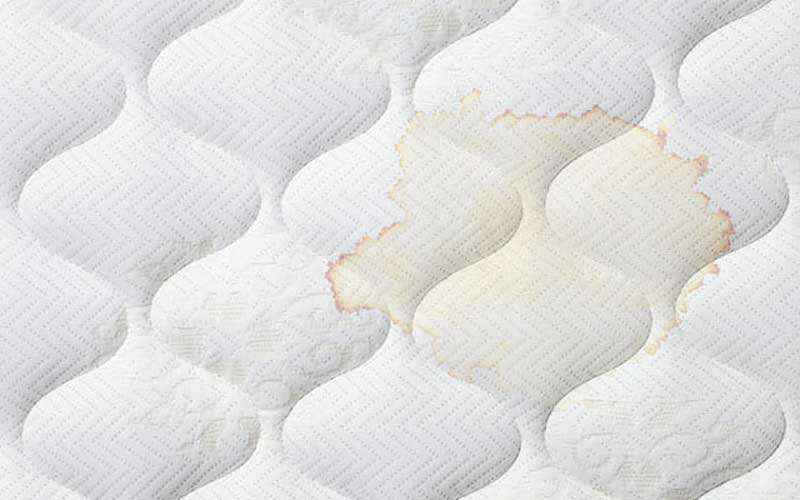
If you have children or pets, it can be easy to spill or even for urine to leak through the sheets at night. Cleaning those stains won’t be as hard without the right cleaning materials. That’s why we’ll try to teach you how to clean a mattress deep.
You can either purchase a cleaner from the store or make one yourself. To remove a tough stain such as urine, you must use a mixture of three tablespoons of baking soda, 240ml hydrogen peroxide and 1/2 teaspoon of liquid dish soap.
Apply the mixture and rub lightly until it is removed, but if that doesn’t work, you can try to combine three tablespoons of laundry powder with one tablespoon of water and spread the solution over the urine stain. Let it sit for at least 30 minutes, remove the paste, and vacuum.
How to clean blood stains off a mattress?
Bloodstains are not as common as urine stains and are a lot harder to get rid of, but if it’s that time of the month and an accident happened throughout the night, there is a way to fix your problems. You will need another concoction containing 59 ml of hydrogen peroxide, one tablespoon of salt and one tablespoon of liquid dish soap.
You’ll have to spread the mixture over the blood stain and let it sit for 10 to 15 minutes. After that, you can scrape away with a blunt knife or a spoon. Lastly, you can grab a rag slightly dipped in hydrogen peroxide to remove any excess residue.
How to clean a mattress with baking soda and vinegar?
Cleaning a mattress with baking soda and vinegar can be a great way to remove stains and odours. First, remove all sheets and bedding from the mattress and sprinkle a generous amount of baking soda over the surface. Let the baking soda sit overnight or overnight to absorb moisture and odours. Next, vacuum the baking soda using the upholstery attachment on your vacuum cleaner.
After vacuuming, mix equal parts of water and white vinegar in a spray bottle and lightly mist the mattress. The vinegar will help disinfect and deodorize the mattress. Let the mattress air dry completely before placing clean sheets and bedding back on. It’s important to avoid saturating the mattress with too much liquid, as this can lead to mould and mildew growth.
How to take care of your mattress to prolong its life?
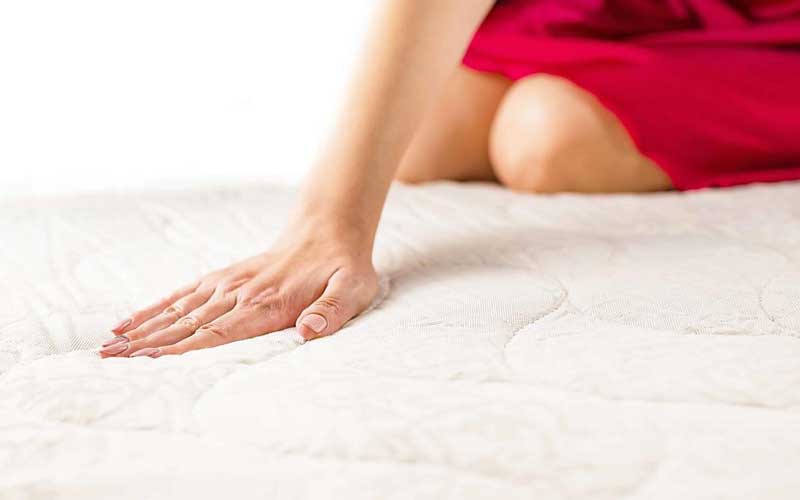
Taking care of your mattress is important to ensure that it lasts as long as possible and remains comfortable to sleep on. Here are some tips on how to take care of your mattress:
- Rotate or flip your mattress regularly to prevent uneven wear and tear. Most mattresses should be rotated or flipped every 3-6 months.
- Keep your mattress clean by regularly washing your bedding, using a mattress protector, and vacuuming the surface to remove dust and dirt.
- Avoid sitting or standing on the edges of your mattress, as this can cause the edges to sag over time.
- Use a supportive bed frame or foundation to prevent the mattress from sagging or becoming damaged.
- Keep your mattress dry and well-ventilated to prevent mould and mildew growth. Avoid spilling liquids on the mattress and use a dehumidifier in humid environments.
By following these tips, you can help extend the life of your mattress and ensure that it provides a comfortable and restful sleep experience for years to come. You can also use a mattress protector to protect your mattress as well.
Bottom line
Now that we’ve told you how to clean a mattress, it’s time for you to do some work to keep it fresh and clean. If you have a bust life and can’t remember when you’ve last cleaned your bed, you should make a schedule or set a reminder on your calendar so that your mattress is regularly deep cleaned and always fresh! Alternatively, you can look into replacing your mattress – check out what we think are the best ones in the UK for this year!
We hope we were able to help you in your venture of keeping keep your mattress clean for longer. Now it’s our turn to hear from you if any questions regarding the subject were left unanswered.

